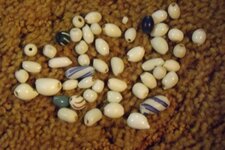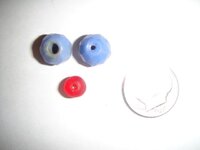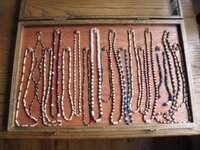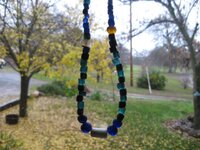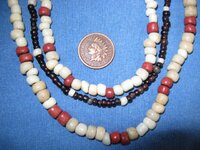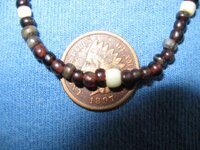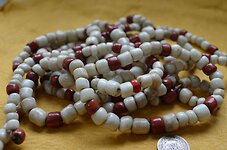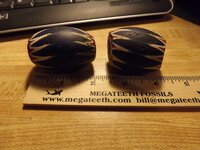BosnMate
Gold Member
- Sep 10, 2010
- 6,916
- 8,441
- Detector(s) used
- Whites MXT, Whites DFX, Whites 6000 Di Pro
- Primary Interest:
- Other
I have a small collection of glass trade beads.
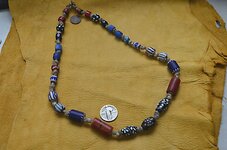
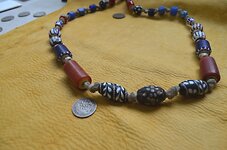
I'm no means an expert, and I've forgotten stuff I learned a few years ago. First, most trade beads you see for sale today came from Africa. They are exactly the same beads that were being traded in north America at the same time. There is one bead that was traded only in the Pacific North West, and that is the cobalt blue Russian Facet. Otherwise a person only knows if the bead was traded in north America if it's found in this country like any other artifacts. The story on trade beads is fascinating, but I'm not longed winded enough to get into that this evening. The first beads are called Russian Facets, and they were traded extensively in the Pacific Northwest. I've seen some really large Russian facets that were found in the area around Pyramid Lake in Nevada.
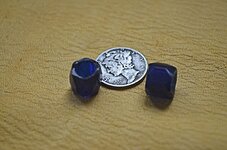
Next, the one on the left of the dime is called a Lewis and Clark. Supposedly that is a style of bead traded on the expedition. I don't know the truth of that, but I read in their journals that they ran out of blue beads, and the Natives on the coast wanted blue beads, and would hardly trade for anything else. The other redish bead was traded to the Qunault Nation on the coast of Washington state, by the Hudson Bay Company.
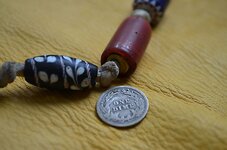
The next beads are called "white hearts. These beads range in size from tiny seed beads to quite large. If you find one of these beads that has a pink heart, that supposedly means the gold in the red portion is migrating into the white area, and that takes several hundred years.
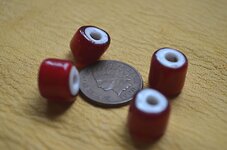
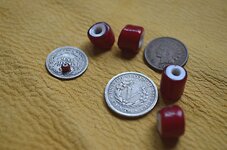
Note the little tiny white heart seed bead.
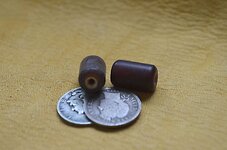
Above these beads are a couple of white hearts that were found in Northern California. They were recovered on top of the ground, off a mound of dirt that a ground squirrel had dug up.
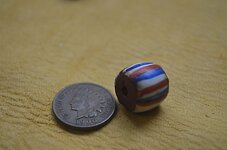
The above bead is called a "Manhattan," as supposedly $21 of this type of bead purchased Manhattan for the Dutch. This bead is a crude knock off of the Chevron bead, which is pictured below.
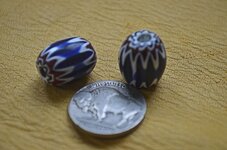
The Chevron bead comes in many sizes, all the way from small to huge. Many of these beads are being made today, so before you pay big money for a bead, be sure it's not a modern knockoff.
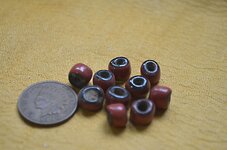
This brick red bead has a green heart, as I think it's called a "cornealian." My spell checker says that's spelled wrong, and I have no idea how to spell it -- anyhow these beads were also found in northern California.
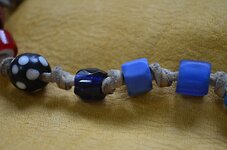
Above, I think the one on the left is called a "skunk" bead. Next is a Russian Facet, then the two light blue faceted beads are NOT Russian. Those particular beads probably come from Africa, as does the French Ambassador bead to the left, and the Lewis and Clark, pictured below.
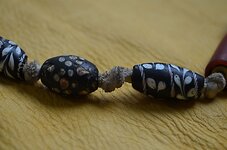
And finally, the last picture, there are a couple of Manhattans, a chevron, and the last kind of red floral bead looks just like tribal beads I saw in Fernley, Nevada.
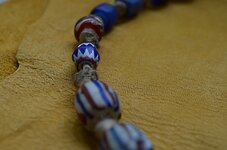


I'm no means an expert, and I've forgotten stuff I learned a few years ago. First, most trade beads you see for sale today came from Africa. They are exactly the same beads that were being traded in north America at the same time. There is one bead that was traded only in the Pacific North West, and that is the cobalt blue Russian Facet. Otherwise a person only knows if the bead was traded in north America if it's found in this country like any other artifacts. The story on trade beads is fascinating, but I'm not longed winded enough to get into that this evening. The first beads are called Russian Facets, and they were traded extensively in the Pacific Northwest. I've seen some really large Russian facets that were found in the area around Pyramid Lake in Nevada.

Next, the one on the left of the dime is called a Lewis and Clark. Supposedly that is a style of bead traded on the expedition. I don't know the truth of that, but I read in their journals that they ran out of blue beads, and the Natives on the coast wanted blue beads, and would hardly trade for anything else. The other redish bead was traded to the Qunault Nation on the coast of Washington state, by the Hudson Bay Company.

The next beads are called "white hearts. These beads range in size from tiny seed beads to quite large. If you find one of these beads that has a pink heart, that supposedly means the gold in the red portion is migrating into the white area, and that takes several hundred years.


Note the little tiny white heart seed bead.

Above these beads are a couple of white hearts that were found in Northern California. They were recovered on top of the ground, off a mound of dirt that a ground squirrel had dug up.

The above bead is called a "Manhattan," as supposedly $21 of this type of bead purchased Manhattan for the Dutch. This bead is a crude knock off of the Chevron bead, which is pictured below.

The Chevron bead comes in many sizes, all the way from small to huge. Many of these beads are being made today, so before you pay big money for a bead, be sure it's not a modern knockoff.

This brick red bead has a green heart, as I think it's called a "cornealian." My spell checker says that's spelled wrong, and I have no idea how to spell it -- anyhow these beads were also found in northern California.

Above, I think the one on the left is called a "skunk" bead. Next is a Russian Facet, then the two light blue faceted beads are NOT Russian. Those particular beads probably come from Africa, as does the French Ambassador bead to the left, and the Lewis and Clark, pictured below.

And finally, the last picture, there are a couple of Manhattans, a chevron, and the last kind of red floral bead looks just like tribal beads I saw in Fernley, Nevada.

Upvote
0




